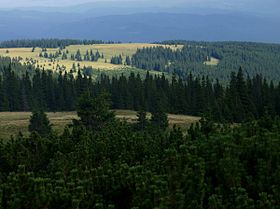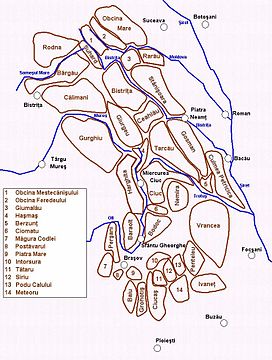Călimani Mountains
| Călimani Mountains | |
|---|---|
 |
|
| Highest point | |
| Peak | Pietrosul Călimanilor (Mureș County) |
| Elevation | 2,102 m (6,896 ft) |
| Coordinates | 47°7′30″N 25°11′9″E / 47.12500°N 25.18583°ECoordinates: 47°7′30″N 25°11′9″E / 47.12500°N 25.18583°E |
| Dimensions | |
| Length | 160 km (99 mi) |
| Width | 40 km (25 mi) E–W |
| Area | 6,400 km2 (2,500 sq mi) |
| Geography | |
|
Location of Călimani Mountains within Eastern Carpathians
|
|
| Country | Romania |
| Counties | Mureș, Harghita, Suceava and Bistrița-Năsăud |
| Borders on |
List
|
The Călimani Mountains (Romanian: Munții Călimani, Hungarian: Kelemen-havasok) are the largest volcanic complex of the Carpathian Mountains in Transylvania, Romania. Geologically they belong to the Căliman-Harghita Mountains group of the Inner Eastern Carpathians.
Maximum height is reached in Pietrosul Călimanilor Peak, at 2,102 m. Other significant peaks include: Bistriciorul (1,990 m), Stuniorul (1,885 m), Gruiului (1,913 m), Negoiul Unguresc (2,084 m), Rețițiș (2,021 m), Bradul Ciont (1,899 m), Iezerul Călimanilor (2,023 m). The volcanic crater with a diameter of 10 km is bordered by the highest peaks, and to north is split by Valea Neagră, a tributary of Dorna River. Inside the crater there are several secondary volcanic funnels (Pietricelui, Vârful Haitei, Negoiul Românesc), some of which are now exploitations of sulfur.
Among the major tourist attractions include odd shapes of volcanic rocks on Tihul, Rusca and Rețițiș Mountains, but especially on Tămău and Lucaciu Mountains. In the last sector can be found the geological reserve 12 Apostles.
The Călimani Mountains, alongside Gurghiu and Harghita Mountains, fall in the southern group of the youngest mountains in Romania, with extinct craters about 1.8–5 million years ago (Lower Quaternary), that formed in the Upper Pliocene (late Tertiary Neogene). Intense Neogene volcanic activity led to the emergence of huge accumulations of lava spread over a length of 450 km (of which 375 in Romania). Consisting of alternating lava, agglomerates and ash (stratovolcano), the Călimani belongs to the southern group – the most important volcanic mass – with an area of approximately 6,400 km², with a width of about 40 km and a length of nearly 160 km.
...
Wikipedia

